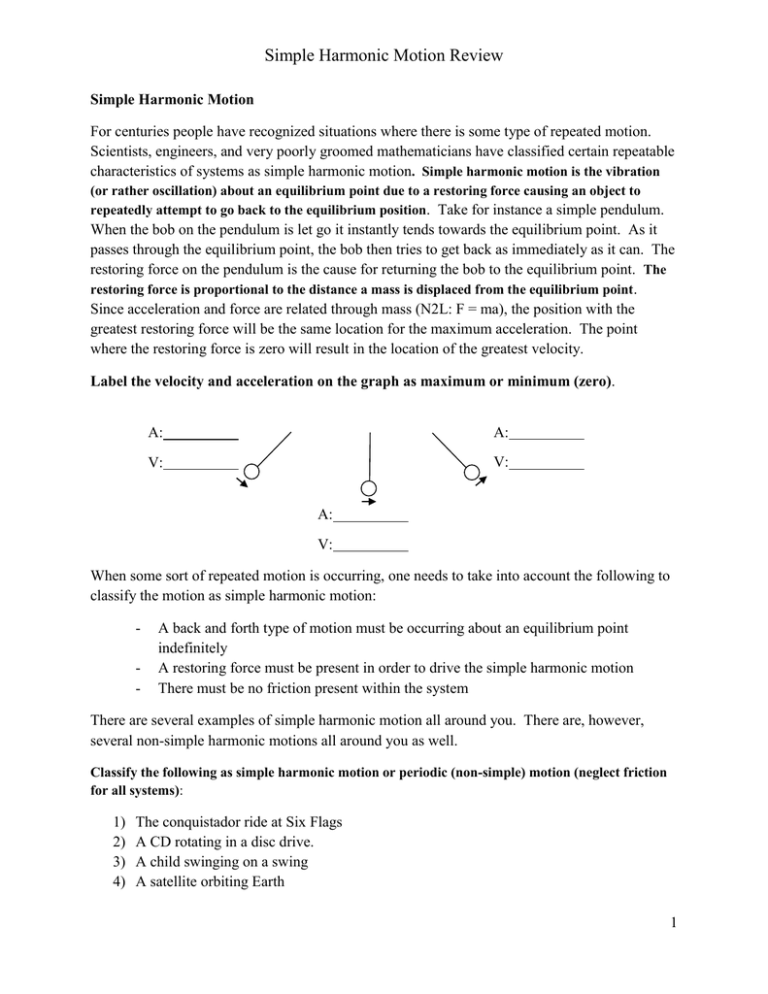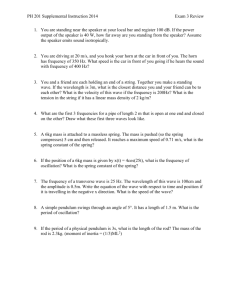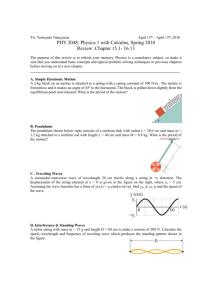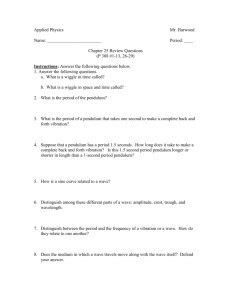Simple Harmonic Motion Review Simple Harmonic Motion For
advertisement

Simple Harmonic Motion Review Simple Harmonic Motion For centuries people have recognized situations where there is some type of repeated motion. Scientists, engineers, and very poorly groomed mathematicians have classified certain repeatable characteristics of systems as simple harmonic motion. Simple harmonic motion is the vibration (or rather oscillation) about an equilibrium point due to a restoring force causing an object to repeatedly attempt to go back to the equilibrium position. Take for instance a simple pendulum. When the bob on the pendulum is let go it instantly tends towards the equilibrium point. As it passes through the equilibrium point, the bob then tries to get back as immediately as it can. The restoring force on the pendulum is the cause for returning the bob to the equilibrium point. The restoring force is proportional to the distance a mass is displaced from the equilibrium point. Since acceleration and force are related through mass (N2L: F = ma), the position with the greatest restoring force will be the same location for the maximum acceleration. The point where the restoring force is zero will result in the location of the greatest velocity. Label the velocity and acceleration on the graph as maximum or minimum (zero). A: A: V: V: A: V: When some sort of repeated motion is occurring, one needs to take into account the following to classify the motion as simple harmonic motion: - A back and forth type of motion must be occurring about an equilibrium point indefinitely A restoring force must be present in order to drive the simple harmonic motion There must be no friction present within the system There are several examples of simple harmonic motion all around you. There are, however, several non-simple harmonic motions all around you as well. Classify the following as simple harmonic motion or periodic (non-simple) motion (neglect friction for all systems): 1) 2) 3) 4) The conquistador ride at Six Flags A CD rotating in a disc drive. A child swinging on a swing A satellite orbiting Earth 1 Simple Harmonic Motion Review Random Stuff… There are some simple harmonic oscillators that we can analyze in this class: the mass-spring system and a simple pendulum. Of special note is the pendulum. In order for the pendulum to remain a simple harmonic oscillator, the pendulum must not start at a starting angle greater than 15°. If one starts a pendulum at too large an amplitude you put yourself, and more importantly the pendulum, in the non-linear regime. You can either come into tutorials to hear more about non-linear systems or wait till your junior, senior, or graduate level year in engineering school. Waves With simple harmonic oscillators, we are forced to nothing but regard waves, wave motion, wave properties, and wave behavior. Match the following terms with their definitions 1) Amplitude a. 2) Crest b. 3) Trough c. 4) Wavelength d. 5) Frequency e. 5) Period f. 6) Transverse Wave g. 7) Longitudinal (Compression) Wave h. The number of waves that occur in 1 second The motion of the wave is in the same direction as the wave’s motion When two or more wave to combine to form a new wave The spreading of a wave due to a corner or barrier The vibration of one object because of another wave oscillating at the object’s natural frequency Spread out portion of a compression wave When waves continuously interfere with one another Lowest point on a wave 8) Interference i. The length of one cycle of a wave 9) Diffraction j. Highest point on a wave 10) Rarefaction k. 11) Resonance l. The motion of the wave is perpendicular to the direction of the wave The height of a wave 12) Standing wave m. The amount of time it takes for 1 cycle of a wave to occur 2 Simple Harmonic Motion Review Using the picture below answer questions 13 to 18 f = 1.0/T 13) Label two crests on the graph. 14) Label two troughs on the graph. 15) The amplitude of the wave is 16) The period of the wave is 17) The wavelength, λ, of the wave is 18) The frequency, f, of the wave is It so happens that when we deal with the special simple harmonic oscillators in this class, we can calculate certain characteristics of their motion with a few usually known qualities. Write down the equations for the period of a simple pendulum and a mass-spring system As one can see, the period for the simple pendulum is related to the square root to the length of the pendulum. The only part of a pendulum that will affect it on Earth is the length of the pendulum. In order to double the period of a pendulum, you need to quadruple the length. In order to have half the period, you need to quarter the length of the pendulum! 19) What is the period of a pendulum that is 0.25 m long? 1.0 s 20) How long does a pendulum need to be in order to have a period of 2.0 seconds? 1.0 m 3 Simple Harmonic Motion Review 21) How long does a pendulum need to be in order to have a period of 4.0 seconds? 4.0 m 22) What is the period of a mass-spring system that has a spring with a spring constant of 50.0 N/m for the following masses: a. 1.0 kg 0.88 s b. 25.0 kg 4.44 s c. 1.267 kg 1.0 s The speed of a wave can be found by simply knowing the distance a wave travels for a given time. We happen to have this information: wavelength, λ, (m) and frequency, f, (Hz). v = λf Go back to questions 13 to 18 and answer the following: 23) The speed of the wave is 24) A tuning fork produces a sound with a frequency of 512 Hz and a wavelength of 0.664 m in air. a. What is the value for the speed of sound in air? 340 m/s b. What would be the wavelength of the wave produced by this tuning for in honey where the speed of sound is 6000 m/s? 11.7 m 25) The speed of all electromagnetic waves in empty space is 3.00x108 m/s (the speed of light). Calculate the wavelength of the waves emitted at the following frequencies: a. Radio Waves at 60.0 MHz 5 m b. Visible green light at 5.86x108 MHz 512x10-9 m, 5.12x10-7 m, or 512 nm 4




